Many know of the storied studio Sunrise as the house that spawned classics as varied as The Vision of Escaflowne (1996), Love Live!, and the Gundam franchises. In fact, these works tend to overshadow many of their other works. One of their unknown anime is DT Eightron (1998): a surreal eco-trip that’s a curious work in its own right, not unlike Shoji Kawamori’s Earth Maiden Arjuna (2001).

Notably, this 26-episode series was directed by Tetsurō Amino, still fresh from heading Macross 7 (1994–95). Unfortunately, the anime was all but sidelined by the runaway success of Shinichirō Watanabe’s Cowboy Bebop (1998–99), another Sunrise production that aired around the same time. Comparatively shoe-string production values for the production left it so obscure that there’s little information in English outside of general details on sites like Wikipedia.
https://www.youtube.com/watch?v=VC4Ybz84TVE
DT Eightron‘s OP unwittingly highlights the meager budget the anime had, while also showing its attempts to compensate. (Source: YouTube)
All that being said, is the anime worth your while, or something best kept unknown? That might depend on what you’re willing to stomach. So let’s find out.
A Confused Journey
DT Eightron is set in the bleak future of 2187, generations after war and climate change have devastated the planet. In the domed city of Datania, the people living and working in its cold confines act like emotionless drones at the mercy of the unseen Zero (Masashi Sugawara). One exception to the norm is Shu (Sōichiro Hoshi), a teenager who one day dreams of seeing the sea, which makes him nigh-immune to his “reset” programming. After attempting to escape, he encounters a group of rebels called the Returners, led by Ein (Junichi Suwabe) and May (Rio Natsuki). Together with hacking prodigy Dolly (Akiko Yajima), they decide to journey through the wasteland, in search of the fabled Amaroute. All the while, they’re pursued by a task force led by Nines (Koji Tsujitani), seeking the mysterious substance inside the humans called “DT.”
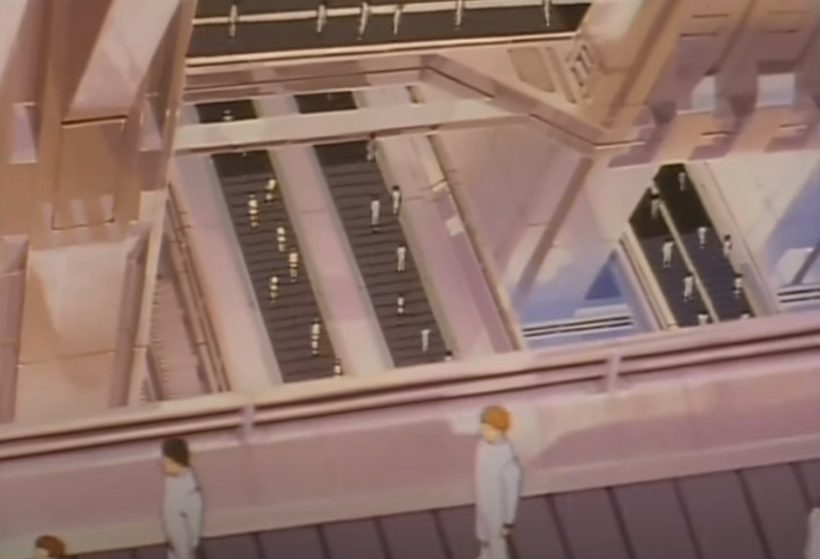
What catches your attention is the high concept. The show is as much an homage to Western sci-fi works like Logan’s Run (1976) in its general tone and post-apocalyptic atmosphere, as it does take more than a few cues from it. While this can come off as derivative, the way the creators mesh these elements with a more humanistic touch, as well as a road trip angle, is certainly unique. Considerable attention is placed on grounding the setting, from the way Datania punishes those who dissent, to how Returners and other survivors manage to live out in a hostile landscape. Even the reveal that Amaroute is a carbon copy of the dystopia the heroes flee from is tempered by a consistent theme of human individuality and determination triumphing over all.
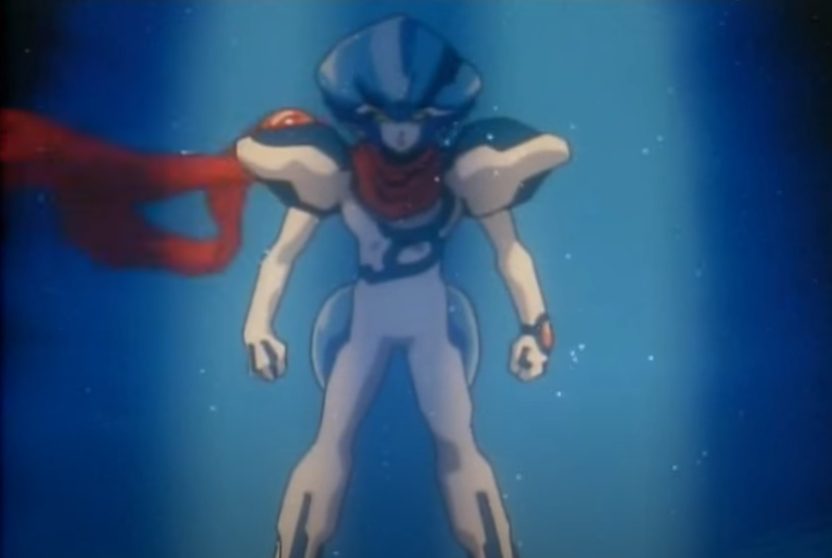
The anime also has a strong environmentalist motif that wouldn’t be too out of place in Captain Planet (1990-96). As the story progresses, it’s made clear how much of the planet was ravaged by human civilization. Shu’s visions of the ocean, in particular, only become more heavy-handed, along with the brow-beating about how mankind ruined nature. Meanwhile, there’s a subplot about the failing, ancient machines which were keeping the Antarctic ice cap from melting which becomes increasingly dominant towards the end. Moreover, the titular Eightron, a “liquid” AI that could create a solid body and red scarf from inanimate material, even serves as a superhero who’s summoned whenever the protagonists are caught in a bind. It’s certainly a unique sci-fi-tinged take compared to Arjuna’s mysticism.
What hobbles these concepts, however, is the execution. The pacing drags and it’s not until the sixth episode that the Returners actually leave Datania. While the subsequent road trip arc is filled with similar padding, whether it’s female escapee Fear (Ayako Kawasumi) struggling with life outside the domed city, or a stopover at a mansion run by homicidal androids. Much of the recurring characters tend to be dull or plain unlikable, with Shu at times coming off as a clueless Shinji Ikari knockoff. The final stretch can seem rushed and abrupt, as though the writers weren’t quite sure how to end off.
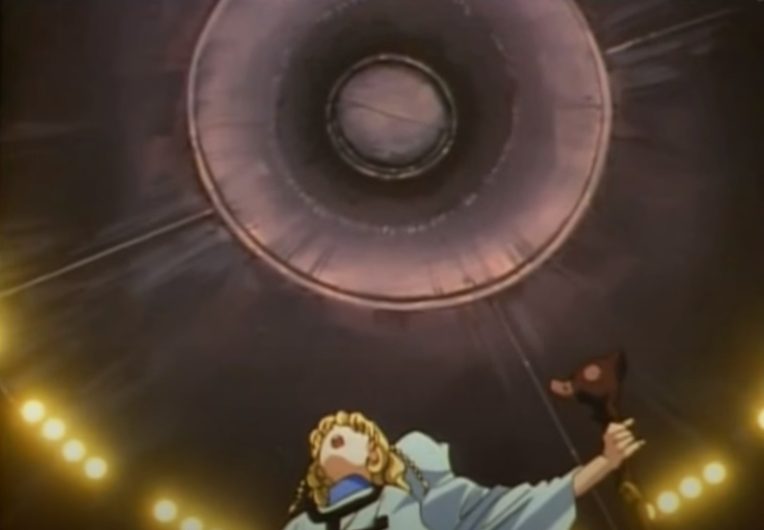
All these result in a confused and uneven adventure. That being said, there are still more than enough curious twists to keep you hooked. That some of the characters, like the nominally antagonistic Nines, have more developed personalities and side plots, certainly help in conveying the lofty ideas being conveyed, however imperfectly.
Down to Earth
Despite Sunrise’s penchant towards decent production values by the late 1990s, DT Eightron’s thin budget is evident in the visuals. The general art style is at once cold, futuristic, post-apocalyptic, and grounded for the most part. This includes the designs for the Returners and other wasteland survivors, to say nothing of the unique techno-organic “Xeno Grafters” and Eightron itself. Where the show flounders is in translating them into animation. You’re as likely to see cut corners, from janky movement to an overreliance on still shots, as notice the inconsistent quality or sloppy fights. Even with the incorporation of CGI, thanks in part to Amino’s Satelight connections, at best the series can come off as dated.
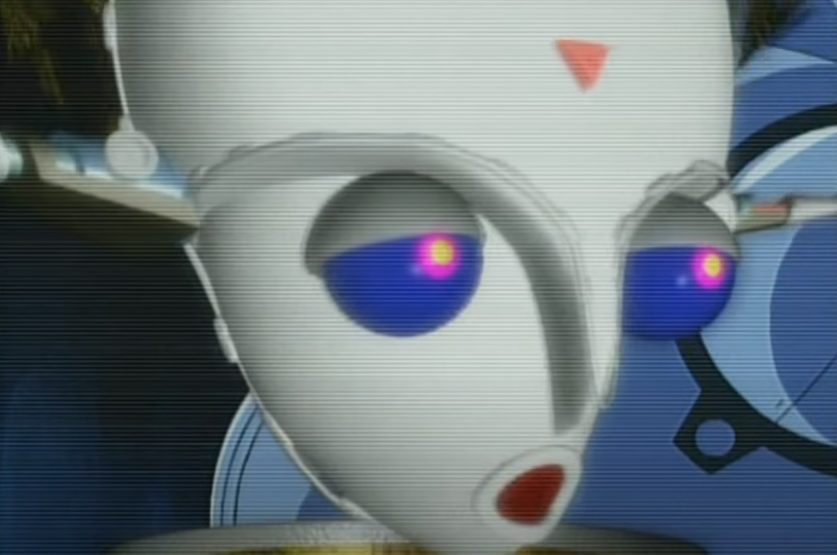
Then, there’s the audio. The voice acting is wildly disproportionate, with the performances ranging from energetic, if at times annoying, to painfully dull. While there are some high points, like the smug Dr. Genesis (Yoshito Yasuhara), Sōichiro Hoshi’s flat delivery as Shu does more of a disservice than anything else. On the other hand, the music makes a solid effort to compensate. While it doesn’t take long to get repetitive, another sign of the anime’s restraints, the soundtrack’s blend of synth, techno, and rock are strong enough to make the action look enticing. If anything, the opening theme song by J-rock group Dragon Ash is its highlight, far outlasting the show it’s made for.
Although DT Eightron was broadcast across Asia through Animax, and saw a DVD release in 2010, it received middling attention. The handful of Western reviewers who saw it, meanwhile, were rather mixed. While some lambasted it as a mediocre Evangelion clone with a climate change veneer, others saw it as a solid romp held back by its budget and execution. Either way, the successes of Cowboy Bebop, and soon after, Turn A Gundam (1999), ensured that it would never get such a chance to really prove itself.
For all its faults, it’s a shame. Though not Sunrise’s best work, the series is by no means a bad anime. If you’re into post-apocalyptic sci-fi, with an environmentalist flair, then this show might be worth a few hours of your time.


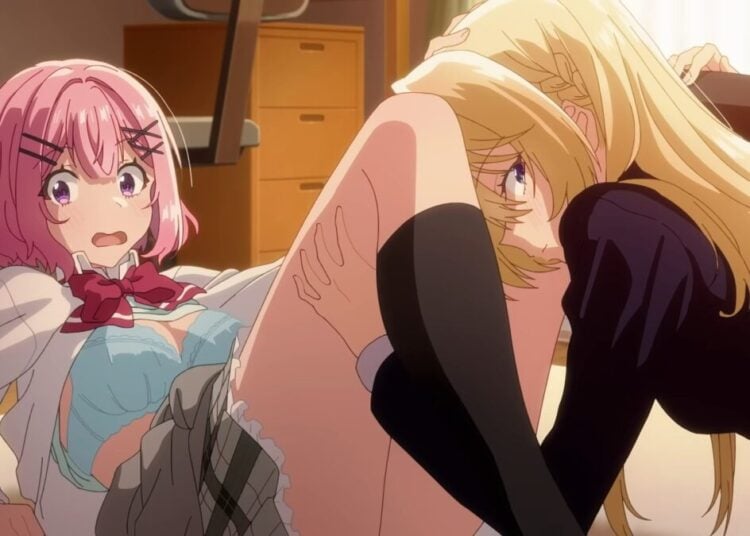
![Sawaranaide Kotesashi Kun Episode 12 [END] Featured Image](https://blog.jlist.com/wp-content/uploads/2025/12/Sawaranaide-Kotesashi-kun-Episode-12-END-Featured-Image-750x536.jpg)










